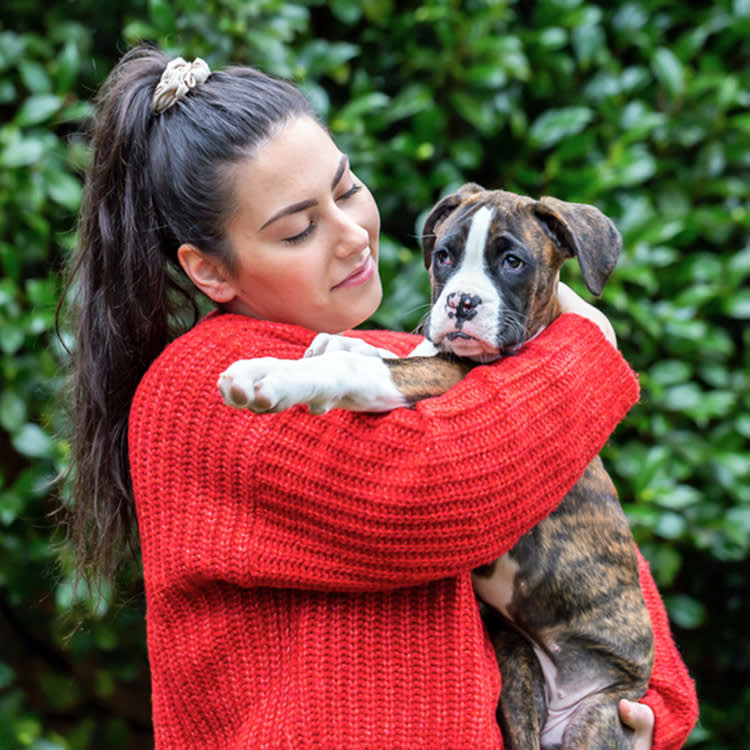These Dogs Are Twice as Likely to Develop Chronic Skin Conditions, New Study Says
New research found which pups are at highest risk for atopic dermatitis.

Share Article
You might be familiar with atopic dermatitis, aka the most common type of eczema. The chronic skin condition is often triggered by allergens, causing dry, itchy, and inflamed skin — and it can cause serious discomfort in both humans and dogs. A new study from Mars Petcare’s Biobank projectopens in new tab has found that French Bulldogs and Boxers are twice as likely to develop the condition.
In dogs, atopic dermatitis (referred to as canine atopic dermatitis, or cAD) manifests as excessive itchiness. Dogs will often scratch behind their elbows, lick and chew their feet, and rub their faces. Because their fur covers their skin, it can be harder to spot topic dermatitis in dogs than in humans — but often, all the excessive scratching and licking will result in hair loss, revealing rashes and darker skin patches. Prolonged licking and scratching can lead to further infections, causing even greater irritation and discomfort.
Like the human equivalent, cAD doesn’t have a permanent cure. Instead, dog parents must manage the condition as it flares up by identifying what triggers it and administering topical treatments and oral medications to mitigate the symptoms.
In the new study, researchers examined the DNA of 1.2 million dogs using samples from the Mars Petcare Biobank and Wisdom Panel. The Biobank project is a cat and dog genome database, created in partnership with the Broad Institute of MIT and Harvard to help advance pet health care.
How much do you spend on your pet per year?
The researchers determined that a splice variant in SLAMF1 — a protein that plays a crucial role in the immune system — was a likely contributor to an increased risk of cAD. This is the first time that particular gene has been linked to atopic dermatitis in any species. Additionally, the study detected that SLAMF1 variant in 71 percent of French Bulldogs and 40 percent of Boxers, which means those two breeds are twice as likely to develop cAD.
This marks the first completed study of the Mars Petcare Biobank since the project started in June 2022. The project aims to sequence the DNA of over 20,000 dogs and cats over the next decade. Currently, 4,000 pets have been enrolled in the study. Eventually, the data will be publicly available and offer insights on pet breed ancestry, genetic mutations linked to disease, and information on pet aging.
“The opportunity to better understand cat and dog genetics through specifically designed gene sequencing studies is an important milestone that will help us deliver on our purpose: A Better World For Pets,” Nefertiti Greene, president of Mars Petcare Science & Diagnostics, told Pet Food Processing in 2023opens in new tab. “Together with our partners at the Broad Institute we hope to find several key ways to provide clinically focused, real-world data. This is essential for developing more effective precision medicines and that lead to scientific breakthroughs for the future of pet health.”
Related articles
![Woman hugging her senior Golden Retriever dog.]()
Certain Kinds of Dogs Are More Likely to Get Cancer, New Study Finds
Genetics and environment both play a role.
![Woman holding her Terrier dog in her lap at home.]()
These Dog Breeds Are More Likely to Develop a Deadly Tumor, New Study Says
It’s rare, but knowing your pup’s risk level is key.
![Poodle dog scratching an itch outside in the grass.]()
3 Reasons Why Your Dog Is Itching So Much
A little bit of itching? Totally normal. However, excessive scratching requires a diagnosis.
Why Is My Dog Constantly Scratching, Itching, and Biting Themself?
Here are the most common causes and what you can do about it.
![Brown terrier dog scratching its ear outdoors]()
Relief for Your Dog: Discover Effective Solutions for Their Seasonal Allergies
A vet explains why environmental allergies flare up and what to do about it.
![Dog licking its paw inside by the fire.]()
Hot Spots in Dogs: What Are They, How to Treat Them, and How They Compare to Ringworm
From home treatments to holistic methods—and when to call a vet.





